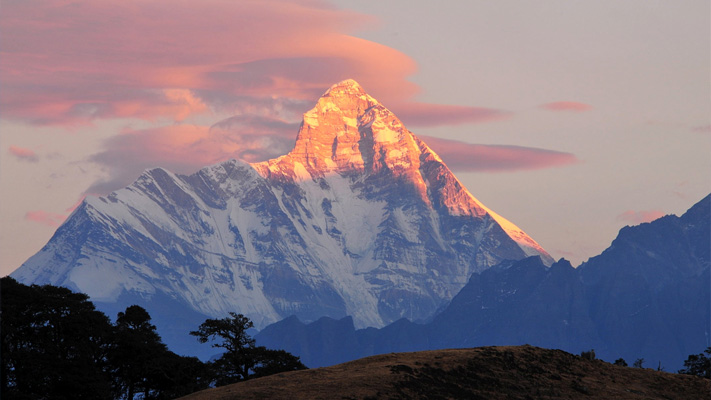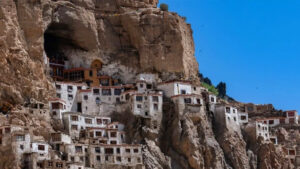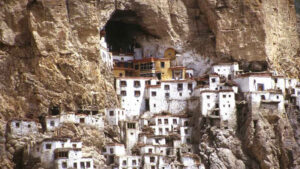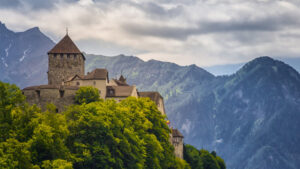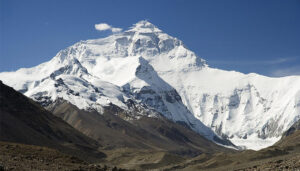NANDA DEVI, UTTARAKHAND – THE MESMERISING AND TOWERING MARVEL OF NATURE

Nanda Devi is a famous mountain located in the state of Uttarakhand in northern India. It is the second highest mountain in India, with an elevation of 7,816 meters (25,643 feet). The name “Nanda Devi” translates to “Bliss-giving Goddess” in the local language.
The Nanda Devi mountain is part of the Nanda Devi National Park, which is a UNESCO World Heritage Site. The park is known for its rich biodiversity and pristine beauty. It is home to several rare and endangered species of flora and fauna, including the elusive snow leopard.

In 1936, a British expedition led by Eric Shipton and H. W. Tilman made the first successful ascent of Nanda Devi. However, due to concerns about the preservation of the fragile ecosystem and the potential risks to climbers, access to the inner sanctuary of Nanda Devi has been restricted since 1983.
The Nanda Devi Inner Sanctuary is a glacial basin surrounded by a ring of peaks, including Nanda Devi itself. It is considered one of the most challenging mountaineering destinations in the world. The restricted area is closely monitored to protect the environment and preserve its unique ecosystem.
Nanda Devi holds cultural and religious significance for the people of Uttarakhand and is considered a sacred mountain. It attracts adventure enthusiasts, climbers, and nature lovers from around the world who come to admire its majestic beauty and explore the surrounding region.
Factors that Make it Worth Visiting
There are several factors that make Nanda Devi in Uttarakhand a destination worth visiting:
- Majestic Natural Beauty: Nanda Devi and its surrounding region boast breathtaking natural beauty. The snow-capped peaks, lush valleys, sparkling rivers, and serene alpine meadows create a picturesque landscape that is truly awe-inspiring.
- Rich Biodiversity: Nanda Devi National Park, where the mountain is located, is renowned for its diverse and unique flora and fauna. The park is home to numerous species of Himalayan flowers, including the beautiful and rare Brahma Kamal. Wildlife enthusiasts may also spot animals like the snow leopard, Himalayan musk deer, and various bird species.
- Adventure Opportunities: Nanda Devi offers exciting adventure opportunities for outdoor enthusiasts. The region is a haven for trekking, mountaineering, and camping. The Nanda Devi Inner Sanctuary, although restricted, presents a challenging and rewarding experience for experienced climbers.
- Cultural Significance: Nanda Devi holds immense cultural and religious significance in the local communities of Uttarakhand. The mountain is considered sacred, and several traditional festivals and rituals are associated with it. Visitors can immerse themselves in the local culture and witness the religious fervor surrounding Nanda Devi.
- Serenity and Tranquility: The remote and secluded nature of Nanda Devi provides a peaceful and serene atmosphere for those seeking solace amidst nature. Away from the bustling city life, visitors can find tranquility and connect with the pristine surroundings.
- UNESCO World Heritage Site: Nanda Devi National Park, including the Nanda Devi Biosphere Reserve, has been recognized as a UNESCO World Heritage Site. This acknowledgment signifies the exceptional universal value of the region and adds to its appeal as a destination worth visiting.
- Photography Opportunities: For photography enthusiasts, Nanda Devi offers a plethora of stunning vistas, landscapes, and wildlife subjects. From panoramic views of the Himalayas to the vibrant flora and fauna, the region provides ample opportunities to capture memorable shots.
Experiences Enjoyed by Tourists
Tourists visiting Nanda Devi in Uttarakhand can enjoy a range of unique experiences. Here are some of the experiences that visitors often cherish:

- Trekking and Hiking: Nanda Devi offers excellent trekking opportunities for adventure enthusiasts. Popular treks include the Nanda Devi Base Camp Trek, Roopkund Trek, Valley of Flowers Trek, and Kuari Pass Trek. These treks take you through stunning landscapes, remote villages, and high-altitude passes, providing an immersive experience of the Himalayas.
- Wildlife Spotting: Nanda Devi National Park is a haven for wildlife lovers. Visitors can go on guided wildlife safaris or trekking excursions within the park to spot rare and endangered species like the snow leopard, Himalayan musk deer, Himalayan black bear, and various bird species. The park’s biodiversity and natural beauty make wildlife spotting a memorable experience.
- Photography Opportunities: Nanda Devi and its surrounding landscapes offer incredible photography opportunities. From capturing the majestic snow-capped peaks to the vibrant alpine flowers and wildlife, photographers can indulge in capturing the beauty of the region.
- Cultural Immersion: Interacting with the local communities and experiencing their unique culture is a highlight for many tourists. Visitors can witness traditional ceremonies, festivals, and rituals that are associated with Nanda Devi. Engaging with the locals provides insights into their way of life, cuisine, arts, and crafts.
- Spiritual and Pilgrimage Journeys: Nanda Devi is considered a sacred mountain, and it attracts spiritual seekers and pilgrims. Many visitors undertake a pilgrimage to seek blessings and spiritual solace. The serene and tranquil atmosphere of the region provides a conducive environment for meditation and self-reflection.
- Exploring Nanda Devi Biosphere Reserve: The Nanda Devi Biosphere Reserve, which includes the national park, offers opportunities for nature walks and birdwatching. Exploring the diverse flora and fauna, pristine forests, and meandering streams is a peaceful and enriching experience.
- Adventure Sports: Besides trekking, Nanda Devi region also offers other adventure sports such as river rafting in the Alaknanda and Ganges rivers, paragliding in the nearby towns of Rishikesh and Auli, and skiing in the winter season. These activities add an adrenaline rush to the overall experience.
It’s important to note that some experiences, like accessing the restricted Nanda Devi Inner Sanctuary, may require special permits and permissions. It is advisable to plan and book these experiences with authorized local tour operators or guides to ensure safety and compliance with regulations.
Top Attractions and Must Visit Places
Nanda Devi and its surrounding region in Uttarakhand offer a wealth of attractions and natural wonders. Here are some of the top attractions you can explore in and around Nanda Devi:

- Nanda Devi National Park: A UNESCO World Heritage Site, the national park is a treasure trove of biodiversity and natural beauty. Explore the pristine alpine meadows, glacial lakes, and stunning landscapes. Keep an eye out for rare Himalayan flora and fauna, including the elusive snow leopard.
- Valley of Flowers: Located near Nanda Devi National Park, the Valley of Flowers is renowned for its vibrant alpine flowers. Trek through the valley during the monsoon season to witness a carpet of colorful blooms, including primulas, poppies, and orchids.
- Auli: Auli is a popular hill station and ski destination located near Nanda Devi. Enjoy breathtaking views of the snow-clad Himalayan peaks, go skiing during the winter season, or take a cable car ride to experience panoramic vistas.
- Hemkund Sahib: Situated at an elevation of 4,329 meters, Hemkund Sahib is a revered Sikh pilgrimage site. Visit the gurudwara (Sikh temple) located beside a glacial lake, surrounded by towering mountains. The pristine beauty and religious significance make it a must-visit place.
- Badrinath: Pay a visit to Badrinath, one of the holiest Hindu pilgrimage sites in India. Explore the ancient Badrinath Temple, dedicated to Lord Vishnu, and take a dip in the sacred Tapt Kund. The town’s spiritual ambiance and scenic beauty are captivating.
- Joshimath: This quaint town serves as a base for several treks in the region. Visit the Narsimha Temple, which dates back to the 8th century, and the Shankaracharya Math. Enjoy the scenic surroundings and peaceful atmosphere.
- Rishikesh: Located at the foothills of the Himalayas, Rishikesh is a renowned spiritual and adventure hub. Explore ashrams, attend yoga and meditation sessions, and witness the Ganga Aarti (ritual worship of the Ganges) on the banks of the river.
- Haridwar: Visit the sacred city of Haridwar, situated on the banks of the Ganges River. Witness the mesmerizing Ganga Aarti at Har Ki Pauri, take a dip in the holy river, and visit ancient temples. The city’s religious significance attracts pilgrims from around the world.
Best Time to Visit
The best time to visit Nanda Devi in Uttarakhand depends on the specific activities you plan to undertake and your preferences. Here is a breakdown of the seasons and their characteristics:

- Summer (April to June): This is the most popular time to visit Nanda Devi. The weather is pleasant, with daytime temperatures ranging from 15°C to 25°C (59°F to 77°F) in lower altitudes. It is an ideal time for trekking, wildlife spotting, and exploring the surrounding areas. However, be prepared for occasional showers and carry appropriate rain gear.
- Monsoon (July to September): The monsoon season brings heavy rainfall to the region, which can result in landslides and make trekking routes challenging. The trails may be slippery and risky during this time, so it is generally not recommended for outdoor activities.
- Autumn (October to November): Autumn is another excellent time to visit Nanda Devi. The weather remains clear and pleasant, with temperatures gradually dropping. The skies are generally clear, offering breathtaking views of the mountains and surrounding landscapes. It is an ideal time for trekking, photography, and enjoying the fall colors of the region.
- Winter (December to March): Winter brings cold temperatures and heavy snowfall to Nanda Devi and its surrounding areas. Higher altitude treks may be inaccessible due to snow and extreme cold.



